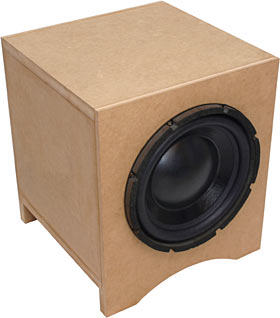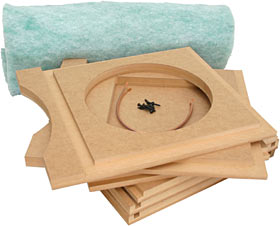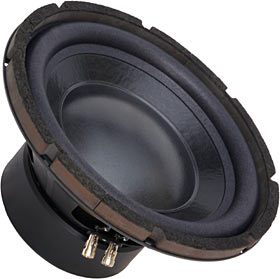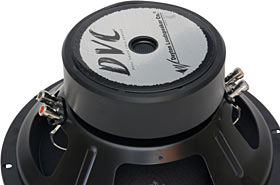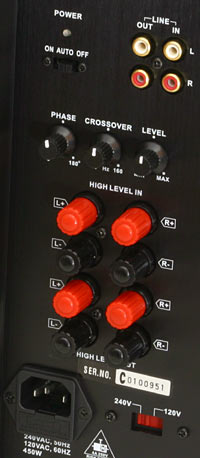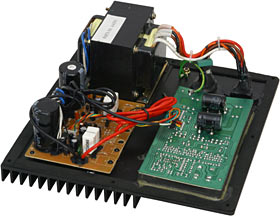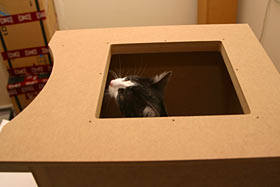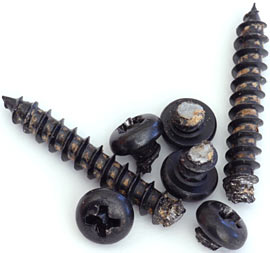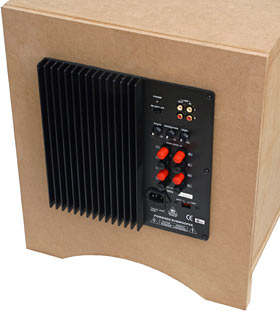
The Loud Speaker Kit S250 Subwoofer
Review date: 4 July 2003. Last modified 22-Feb-2013.
A lot of PC users think they know what a subwoofer is.
It's that little box under their desk, connected to the satellite speakers on either side of their monitor, right?
Wrong.
Lots of "multimedia" speaker systems, and small pseudo-hi-fi rigs as well, have a "subwoofer" that's the size of one to three stacked shoeboxes. Some of these little things do a surprisingly good job of reproducing mid-bass frequencies, considering how small and light and cheap they are. Many are pretty darn ordinary, though, even after you make such allowances.
A real subwoofer is a speaker that reproduces frequencies below those a normal woofer can handle. A "normal woofer" is not one of the drivers in a PC satellite speaker; it's a six to twelve inch diameter driver, as seen in regular hi-fi speakers. Getting below that range means response below 60Hz, at the very least.
A sub needs a frequency range that reaches up to about 100Hz, if you want to be able to use it with small bookshelf speakers (which have little performance below 100Hz of their own). But many buyers of serious subwoofers are just looking for sub-60Hz performance to supplement a speaker system that's already doing pretty well bass-wise.
Below 60Hz is where the fundamental frequencies of thunderous explosions, deep organ notes, water-rippling dinosaur footsteps, deeper-pitched kick drums, and similar coffee-table-rearranging sounds live. You can still hear all of those things through the dinkiest of speakers, but all you're getting in that case are the higher frequency components of the sound. You don't feel the visceral kick of the bass drum, but you hear every other part of the sound, so you still know what it is.
Because the human brain is so good at filling in bass (and treble, for that matter) that it knows ought to be there, it's hardly essential that you have a speaker system that can reproduce the full range of audible bass frequencies, right down to the 20Hz pitch that's usually quoted as the bottom limit for human hearing. Quite a lot of source material doesn't have a lot of bass in it; no subwoofer's going to do much if your speakers spend their time reproducing Mantovani and soap operas. Also, if you've got a very small or very large listening room, a monster subwoofer will be wasted; the lowest bass a room can support is determined by its dimensions, so bedsit-dwellers have a reason besides the possibility of being lynched by their neighbours for not using a thousand watt horn-loaded bass gorilla as a coffee table. Opening the windows only achieves so much.
If you do want solid bass all the way down, though, and have a normal-sized room to listen to it in, a subwoofer is a good way to get it. And a good subwoofer can slot into practically any sound system - regular stereo, home theatre, even computer.
Getting a quality sub into your living room, computer room or bathroom (I'm not judging anyone) for a reasonable price, though, is tricky.
Amplified (active) subs worth bothering with start from about $AU1000 (about $US680, as I write this), and you can pay a lot more to get something really foundation-shaking.
Velodyne CHT-10? About $AU1200. B&W ASW 600? $AU1300 or so. JMLab Electra SW900? $AU3000-odd. Krix Seismix 7, made right here in Australia? $AU3500. Meridian D1500? $AU4400 or more.
This is where kits come in.
A speaker kit gives you all of the parts you need to make a functional, though not necessarily very aesthetically appealing, speaker of far higher quality than you could buy pre-built for the same money. All you need to build most speaker kits is a screwdriver, some wood glue and a few spare hours.
Here in Australia, the inventively named company The Loud Speaker Kit have a comprehensive line of high quality kit speakers. I reviewed one of their cheaper products, the M4 Mini Monitors, a while ago.
[UPDATE: As of 2012, The Loud Speaker Kit were out of business; as of early 2013 they're back under new management, though not with a full line of products yet. There are several other kit-speaker companies both here in Australia and overseas. It can also be easier than you'd think to design your own speakers from scratch!]
The S250 is, right now, the biggest subwoofer kit they make. Build it, and you get a 30 kilogram (66 pound) active subwoofer with the specs to mix it with the big boys. But it only costs $AU999, plus delivery.
(Delivery, by the way, costs $AU13.90 for Melbourne customers and $AU19.90 to me here in Sydney; other shipping rates are easy to determine, but customers outside Australia need not apply.)
What you get
In the S250's imposingly large shipping carton, there are a couple of smaller boxes...
...and there's this.
The S250's panels are all pre-cut, of course, with rebates that let them fit together quite precisely without fasteners to pin them while the glue dries.
Do-it-yourself speaker builders without perceptible woodworking skills often construct basic butt-jointed cabinets that are neither pretty nor particularly strong. Been there, done that. Such cabinets often need to be held together by screws and/or corner braces as well as glue. You'll find none of that kludgery here.
The panels are, of course, made from MDF, because there is no finer material for sanely-priced rectangular speaker boxes (although many homebuilt subwoofers these days use Sonotube).
The S250 box needs no internal reinforcement, partly because it's relatively small (450mm high by 400mm wide by 400mm deep, which is 17.7 by 15.8 by 15.8 inches), and partly because the panels are one whole inch thick. Subwoofers need to be built like brick ablutions blocks, because they spend a lot of time trying to shake themselves apart. Assuming you do your gluing right, the S250 is quite solid enough.
The robustness of the panels makes a big contribution to the weight of this subwoofer. Almost half of its mass is the box.
The green fluff in the background of the above picture is Dacron wadding, which The Loud Speaker Kit admit isn't gen-u-wine DuPont DacronŽ, but is polyethylene terephthalate of adequate quality for the task. That task is slowing down and mildly soaking up sound waves inside the box, to make it seem a bit bigger to the driver, and dampen resonance.
The public relations department.
This hefty item (its magnet assembly is big, but looks bigger, because it's got a protective rubber cap over it) is a 12 inch, dual voice coil puppy with a 600 watt power rating. Both older and newer versions of it have achieved a certain measure of fame.
It's made by "Dayton Loudspeaker Company", which is the house brand of respected US speaker component suppliers Parts Express.
These Dayton drivers are generally recognised as providing an excellent price/performance ratio. They're not up there with the European exotics (this one only has a stamped metal frame, not a cast one! The very idea!), but they're priced to move. Here's the Parts Express page for this driver.
The monstrous 600 watt power rating goes with a resonance below 22Hz (it's very hard to get response out of a speaker that's much lower than the resonant frequency of its bass driver), which will lead audio aficionados to expect a fairly lousy sensitivity figure. Which, indeed, this driver has. It's sacrificing noise-per-watt for bass. No matter; More Power can solve that problem.
The big domed dust cap conceals a lot of the Dayton driver's cone, which is made from "Kevlar impregnated" paper. The word "impregnated" implies that the paper's been saturated with liquid Kevlar, or something, but I think it's actually just got Kevlar fibres mixed in with the much weaker cellulose ones.
Paper is, by the way, a perfectly good material for speaker cones, all by itself, because it's light and stiff. The various treatments used on paper cones (polypropylene coating is a popular cheap one) are there primarily to enhance the paper's toughness and moisture resistance, not to compensate for any inherent acoustic shortcomings.
Two voice coils; two sets of shiny spring terminals.
Dual voice coils are commonly seen in drivers made for car audio applications. Two separate coils are wound on the one former inside the magnet assembly, and you can connect them in parallel to halve the speaker's apparent impedance (two eight ohm coils in parallel give a four ohm speaker), or connect one of them to each output channel of a stereo amplifier.
That's a bad idea if the two channels are delivering significantly different signals, since the two coils will fight each other, but bass is almost always monophonic, so this problem doesn't often arise.
The S250's efficiency is further limited by its simple sealed cabinet - no ports, no sub-enclosures, no passive radiators or other tricks. Sealed enclosures are the simplest kind of bass box, and are very easy to design - the bigger you make 'em, the more bass you get, end of story - but their efficiency is lousy. Ported speakers give you more sound from your electricity.
Even in a sealed box, though, if you feed this driver with a reasonably hefty amp, it'll still be more than capable of loosening the ceiling paint in anybody's lounge room. I speak from experience.
In the S250, the voice coils are connected in parallel, and driven by...
...this. A 275 or 250 watt (depending on how you measure it) fully integrated Class AB amplifier module.
"Plate amps" like this one are the subwoofer-project-builder's friend. One simple unit turns a box and speaker into a full-function, flexible, configurable active sub, which is the best of the three kinds of subwoofer.
The simplest kind of subwoofer is the passive type. It's just a speaker in a box with terminals, operating in the same basic way as other passive speakers. To get it to make a noise, you have to connect it to an amplifier.
This is all very well if you've got a multi-channel surround amp with a subwoofer channel, or if you're happy to deal with the processing and amplification yourself using separate boxes (dusty old receivers are popular candidates for repurposing into subwoofer amps), but it's not a plug-and-go option at all.
Many passive subs have onboard crossovers (also passive, like the crossovers in ordinary passive speakers) and may have output terminals for satellite speakers as well; those ones can just be plugged into the speaker wires from any amplifier and, if you use them with appropriate satellites, will work fine. They won't be running from a separate Low Frequency Effects (LFE) channel then, though.
Then, there's the active sub, with an amp but not necessarily with much in the way of brains. You have to feed it a signal that's been pre-processed to some extent - the sub will probably have its own level control, but won't necessarily have an onboard crossover or any other controls.
And then, there are subs that use integrated amp modules like this one.
It's a featureful gadget.
From top to bottom, you've got the power switch (you can turn the sub off, or on all the time, or put it in "Auto" mode where it powers up when it detects a signal and shuts down again after 15 to 20 minutes with no signal) and a couple of sets of RCA connectors. They let you hook the sub up to dedicated home theatre systems (which usually only have one RCA output for the subwoofer, since it's not a stereo channel), or to anything else with a line out, and then pass the signal through to another device. So you can easily integrate this sub into pretty much any audio rig, including a PC sound system.
If... you dare.
Below the switch and the RCA connectors, there are three knobs. Level is the sub's master volume control. Crossover lets you set the point above which the amp module's 12dB-per-octave filter attenuates the treble, from 40Hz to 160Hz. If you've got big beefy speakers already then 40Hz is likely to be suitable; if you've got dainty bookshelf speakers, then 100Hz or higher will be in order. Higher crossover frequencies make the sub's location more obvious - 100Hz isn't very bassy, and 160Hz is actually only a bit below the E below middle C - but it's better to have the sub playing some mid-bass and giving its position away than to leave a wide trench in the system's frequency response.
And then, there's the phase control. It determines the relationship between the subwoofer's cone motion and the driver motion of the other speakers in the system. That lets you compensate for subwoofer placement, if its compression waves aren't lining up with the compression waves from the other speakers at your listening position.
Subwoofers can play low enough that you can put them anywhere and not be aware of their location, but if you get placement wrong some parts of the room will be relatively bassless while others will sound like a car belting down the highway with one window open. Phase adjustment gives you more positioning flexibility, so you can minimise these "bass nodes" without rearranging the whole room, knocking down a wall, or moving house to a football field.
Next up on the back of the amp, there's a set of screw terminals for high level input and output - another compatibility feature. These terminals work like the RCA connectors, but at speaker level, so you can just stick the sub in the middle of your existing speaker wires. They've got a high-pass crossover that protects the satellite speakers from bass they can't reproduce. Sending high frequencies to a big driver that can't play them is pretty much just a waste of time, but sending low frequencies to a little driver that can't play them will deleteriously affect its fidelity, at best, and can burn it up, at worst.
At the bottom of the amp panel, there's the IEC power receptacle, and a voltage selector switch - the amp will work from 110/120V at 60Hz or 220/240V at 50Hz.
Because of its multi-voltage compatibility, I think the exact same model of this sub is sold in various different countries. Here it is at Parts Express, for instance (it's got small but devoted fan club in the States); here in Australia, Jaycar sell what looks to be the exact same amp for $AU369 (catalogue number AA0501).
The Parts Express page for the amp links to this PDF file, which contains detailed specs for the amp and also tells you how to set it up for different amounts of bass boost by swapping a couple of resistors. The amp that comes with the S250 is already tuned to match it, with 6dB of boost at 30Hz.
The amp module also, by the way, has an integrated rumble filter, which eats up any infrasonic frequencies in the program material. Ultra-low bass, below the threshold of hearing, can't be effectively reproduced by any normal speaker driver, but they'll try - and ultra-low bass is close enough to direct current that it'll strain the biggest sub's voice coil forward and backward, turning it into a toaster rather than a motor.
Rumble filters haven't been as important since most of the world stopped playing LP records, but they can still only make a subwoofer sound better.
The pre-amp board's sealed to the mounting plate with a foam gasket, and the plate itself has another gasket around it. This is important; if the amp board doesn't tightly seal the hole it mounts in on the back of the box, the sub will whistle and buzz like crazy as it pumps air in and out of the leak.
Putting it together
As speaker kits go, this is a surprisingly simple one. And not a tremendously big one, either, by subwoofer standards. But if you're small, frail, or just not at all accustomed to manhandling an object that gets closer to its 30kg final weight with each construction stage, then you may want to enlist some help.
Barring hernias, it should only take about an hour to get the panels together, and rather less than another hour, after the glue's dried, to get the electronics installed.
Before you start slathering glue on everything, the instructions tell you to test-fit the panels so you can see where everything goes. This is good advice; you don't want to have a crisis of confidence when you're holding a panel that's dripping PVA down your arm.
During this stage, other family members may find it necessary to inspect the box from the inside.
They may also sleep on the wadding, but always get up before you can take a picture of them doing it.
The actual box assembly process is simple enough, provided you've done this sort of thing often enough before that when you read instructions which tell you to use amounts of glue described with words like "copious", "ample", or "generous", you know that what they actually mean is "well, not that much, obviously".
Once the box is assembled, the instructions say clamping it while the glue sets is optional. But this thing needs to be strong, so it helps to have at least a couple of large-ish clamps handy.
I clamped the box front to back, as the instructions tell you to do if you're going to clamp it at all, and I also weighed it down a bit with the conveniently-nearby other components.
The boxed woofer and amplifier by themselves weigh about 14 kilos; I added a couple of phone books for luck. That still isn't much vertical clamping force for a box this size, but it's better than nothing.
After leaving the box overnight for the glue to set, it was time to install the other components.
Here, I struck a couple of problems. Fortunately, ordinary customers ought not to encounter them.
First up, the two sets of woofer terminals needed to be joined together with a provided bit of figure-eight cable, and the wires from the amplifier had to be stuffed into one of the terminal sets, too.
The link cable was just barely thin enough to fit through the holes in the spring terminals, but there was no way to twist the amp wires onto the link cable wires and end up with a bundle small enough to fit. I solved the problem by clipping off some of the strands at that end of the link cable, which is more than chunky enough to handle such abuse.
I'm assured that retail S250 kits have the amp wires pre-soldered to the link cable, so it all goes together easily. The kit I got was a pre-production sample.
My other problem was that the pre-drilled pilot holes for the eight driver fixing screws were very, very tight; driving the screws by hand was practically impossible, and assaulting them with a power driver...
...sheared 'em off.
This is often quite easy to do with the anonymous low-quality black screws that people commonly use to attach drivers to speakers; the screws are more than strong enough to hold a driver on, but they've got poor torsional strength and don't deal well with hard driving.
I wrestled a couple of sheared shanks out of the holes, filed down the rest, turned the driver so its mounting holes lay between the failed screw holes, drilled some more generous starter holes, and fixed it with some better quality screws.
Other people ought not to have to do this, at least if The Loud Speaker Kit are to be believed; they tell me they've sold quite a lot of S250's, and only the sample they sent me has had this problem, as far as they know. Fair enough.
Apart from these hassles, assembling the S250 was plain sailing.
The amp module screwed on with no trouble at all. I left it a tad loose, and it whistled and flapped when I started testing the sub, but a swift retightening fixed that.
So the S250's pretty large, yes. It's heavy, yes. But it's not a very advanced project - you could certainly choose an S250 as your first speaker kit.
Finishing
If you want to leave the S250 cabinet without a finish, that's fine; it'll work the same. If you want it to look more professional and/or be more resistant to high humidity, though, you'll need to cover it with something. Paint, veneer, PA-speaker-style carpet, crayon; it's up to you.
The Loudspeaker Kit offer self-adhesive vinyl veneers, and currently have iron-on wood veneer on their price list too.
They also have basic clips-and-cloth grille kits to cover the driver side of the speaker (you have to make your own frame). If you want something more robust to protect the speaker cone from feet, claws or little fingers, any decent electronics store should stock cheap stamped steel grilles.
Jaycar, for instance, will sell you a steel 12 inch grille and set of mounting bolts and T-nuts for well under $AU15. I'd be inclined to just get the grille itself and stick it to the front of the driver with silicone goop; that avoids drilling the front panel for the T-nuts and then caulking the screws into them to stop leaks.
Alternatively, The Loudspeaker Kit will provide on request a variant of the S250 that has the driver firing downwards. That makes it more of a home theatre sub than a music one, if you believe What Everyone Says About Subs, but I'm not convinced that anybody would be able to tell the difference without looking. It ought to solve the driver vulnerability problem well, for anyone who doesn't own ferrets.
Listening tests
The Dayton driver has an unusually stiff suspension - the flexible part of the driver that connects the cone to the frame around its edge and around its neck, inside the speaker. This means it benefits from a few hours of gentle exercise, to loosen the suspension up. I fed it a 25Hz sustained bass note and left it throbbing away at medium volume all day, giving the vague impression that a large diesel engine was idling somewhere in the house.
After that, I played with location and alignment and control settings a bit, until the sub blended into the background as it should.
The idea of a subwoofer is that you shouldn't know it's there. You may notice that the floor's moving rather more than it did the last time you listened to a spot of Bach (or K&D, or Evangelos Papathanassiou, or Spacetribe, or what have you), and your home theatre may suddenly sound a lot more like a multiplex, but the sub shouldn't jump out and say hello.
If you ask it to, though, it certainly will.
Those who're tempted to wind everything up to eleven and see what the heck happens may well give themselves a rather nasty surprise if they try it with a Real Sub like this one. It's all a bit of fun when you're only fiddling with an over-specified, over-pumped, over-grown set of computer speakers like the Logitech Z-560s, but if you try the same thing with the S250 you'll discover that a sound intensity of "at least 105dB at 20Hz" means that anybody who walks through a bass node in your listening room may suddenly find themselves swallowing their fillings.
There are, undeniably, people who enjoy that feeling. Someone must buy those "Bassy McBass and His Bass-Bumping All-Bass Big Bass Band (Extra Bass Mix)" CDs and play them as they're meant to be played, through at least six 18 inch subs in the back of a boom car. If that's what you're into, then an S250 will give you a not dissimilar experience in the privacy of your home.
All of those tracks just sound like someone diddling the bottom register of a TB-303 to me, though, so I stuck to more mainstream program material in my testing.
The S250 turned in an excellent performance on a variety of bass-heavy music and movies. Some of my test material turned out to be rather less bass-heavy than I'd thought, from listening to it on lesser speakers and with headphones; that's not the S250's fault. The sub did justice to everything that had low bass. And the phase control worked - though, since I ended up lining the sub up with the main speakers, I left it on its zero setting in the end - and so did the crossover control and the auto-power-on. An LED above the power switch glows red when the sub's in standby and green when it's on, so it's easy to see when it's detected a signal.
Thanks to the amp module's 30Hz bass boost, this sub definitely does have serious output at 25Hz and below. So I think it'd have to be a darn picky music-or-movies enthusiast who wouldn't find it adequate for their needs.
Overall
It's unfair to directly compare kit speakers with pre-built ones. The building process, for well designed kits like this one, isn't a big deal for anyone slightly handy. But neither is one of these things a plug-and-go experience.
Pre-built speakers will also come with at least a cheap vinyl veneer finish; a lot of expensive subs have gorgeous real wood veneers, or are even made from solid timber, not "engineered wood" like MDF.
If you ask me, though, these caveats aren't serious when you look at what you're getting for the money with the S250.
If you like the idea of the S250 but still want more, you'll soon be able to get it. The S350 kit is coming, with a bigger ported cabinet for even more bass extension, and substantially higher efficiency, for $AU1299. Threshold of pain and broken filaments in every light bulb in the house, here we come.
I'll settle for the S250, though. It's a manageable size, it's got slabs of power despite its basic efficiency limitations, it goes together easily enough, and it costs little more than the most basic serious pre-built subs. Which it outperforms by miles.
Highly recommended.
Review S250 kit kindly provided by The Loud Speaker Kit.
[UPDATE: As of 2012, The Loud Speaker Kit were out of business; as of early 2013 they're back under new management, though not with a full line of products yet. There are several other kit-speaker companies both here in Australia and overseas. It can also be easier than you'd think to design your own speakers from scratch!]
